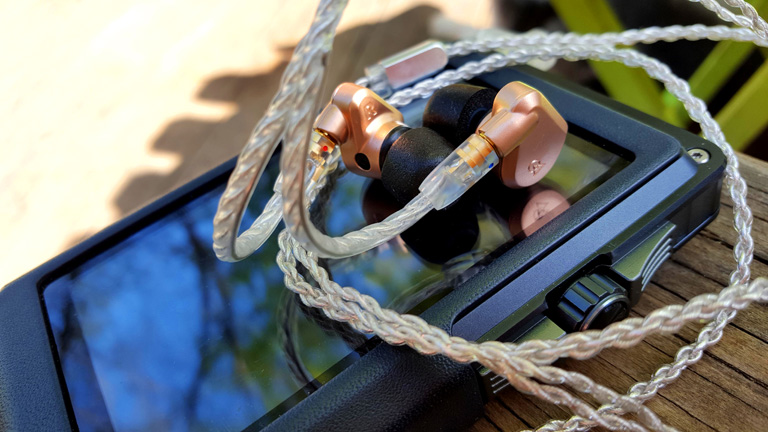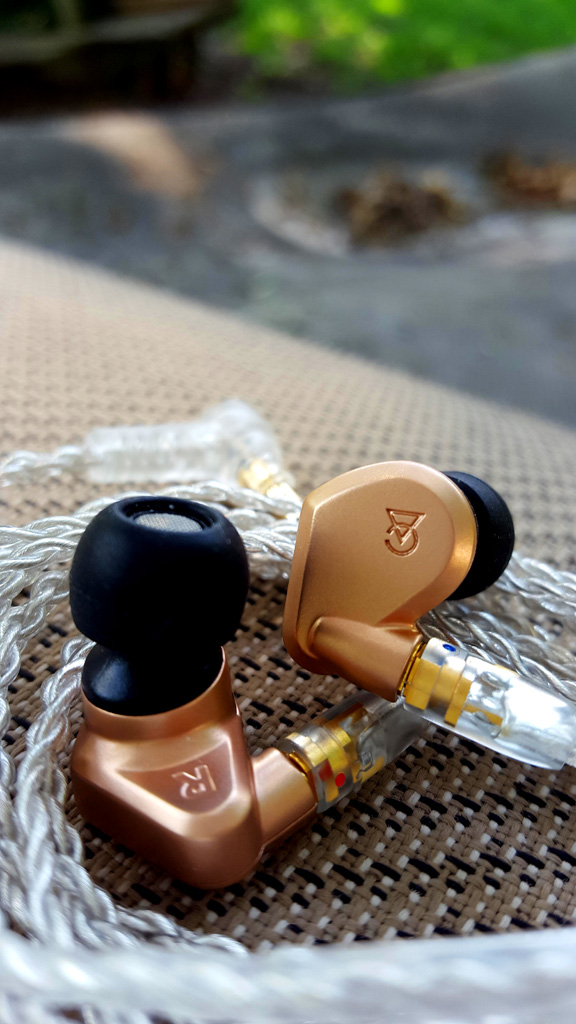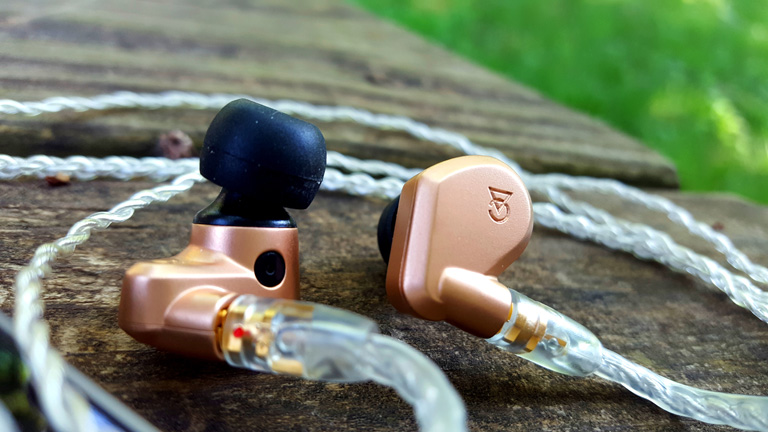
Campfire Audio Dorado is tuned for warmth and smoothness, using an L-shaped signature, with bass heightened over neutral mids and treble. Notions of resolution and details take a backseat to CA’s ambition for ultimate naturalness. I’ve never heard such an organic, velvety earphone, and one which maintains an open, airy stage.
There’s no point going on until I talk about the bass, as this is the perfect example of what I expect from a hybrid IEM. In my mind, the only reason to put a DD in the low-end is if you want to achieve something that just couldn’t be done with a BA. Unique Melody Merlin did not meet these expectations. Dorado does. No array of Balanced Armatures could produce this level of rightness or physical slam. The lows are big, thick, and oh so smooth, with sub-bass rumble that’s out of this world. Its tonality makes your mouth water it’s so rich and decadent. The decay is slow, lingering in that wonderful acoustic fashion. In short, it’s the finest bass I’ve ever heard in an IEM.
The vocals are not awfully thick, but possessed of a kind of effortless, airy quality. Sharing the Dynamic Driver with the bass, you get that same satiny texture. Great warmth permeates the mid-range. After about 150 hours of burn-in, the vocals do become decently clear and articulate, though they will always suffer a kind of wooliness/veil. They simply aren’t capable of the detail and transparency of my other IEMs. What you get in the trade is a smooth, scrumptious presentation, and enough musicality to override any criticisms. Dorado is a savage joy in the ears.

Dorado’s treble has great note weight, and that unmistakable sweet character I’ve come to associate with Campfire’s TAEC design. It’s like honey poured in your ears. The only thing that came close to it was JHAudio Angie, and this is even better. Dorado produces highs that sparkle only a little, and aren’t emphasized in any obvious way. Though, they aren’t under-emphasized either. They’re quite neutral with the mids, overshadowed only by the bass. Here is the only frequency range were the Balanced Armatures are used, and it gives the upper spectrum a tone to standout from the crowd. They aren’t overly smooth or earthy, like the mids and bass, but rather ethereal in nature. The TAEC BA’s and the Dynamic Driver come together cohesively in a spectacular, unique sound, one which I’ve grown terribly fond of.
Soundstage is deceptively large. Due to the warmth, you’d think the stage might be a bit constrained, but in fact it’s fairly vast. The width is exceptional, the depth is above average, height is decent. Even amongst far more expensive TOTLs, Dorado stands out here. Resolution, transparency, and details are not quite at that same level, however. And while imaging and separation are good, without that resolution, they don’t have the same impact on your perception.

The all BA Jupiter is a very different beast. The first thing I notice is how the vocals are pushed back a couple of steps on the stage. Yet they are clearer and more detailed. Dorado is smoother and lush, but Jupiter is more energetic and precise. Jupiter’s mid-section is not as warm, though it is nowhere near cold. It’s simply aiming for a more transparent sound.
Jupiter’s treble is a lot like Dorado’s, as they use the same duel BA TAEC setup. Except on Jupiter, the highs are emphasized above the vocals. There’s more energy and shimmer. I would not call it sharp or fatiguing, they simply try harder. This brings in extra light, revealing details Dorado may overlook.
Bass is just as exaggerated as the highs, filling out the other end of this U-shape signature. Yet they don’t seem as prominent as Dorado’s lows. While Jupiter manages a good, warm tone, with some sub-bass, it’s nothing like the exquisite wealth Dorado boasts.
You don’t get the same soundstage, either. Not at all. Jupiter is narrower, but deeper, and certainly taller. It also beats Dorado in separation, though it’s more or less equal in imaging. Jupiter gives off the impression of rendering at a higher resolution, while Dorado wants to romance you with musicality.

The closest fellow I have to Dorado is the 64Audio U12, using APEX M15 module, and, to be as fair as possible, a silver-plated copper single-ended cable. The Pandora, by Rhapsodio. Well, Solar is sort of close, also. But Solar has a traditional U-shape profile, whereas Dorado and U12 are L-shaped.
The first thing that strikes you is how different the bass is. Going from a Dynamic Driver to four Balanced Armatures for the low-end, the U12 still fails to match that effortless, authentic punch and rumble, though it is the best I’ve ever heard from BAs. The U12 is capable of remarkable sub-bass, and a very warm, hearty tone, but Dorado just flat out tramples it. The areas U12 manages to win are in speed and details. Dorado is slower, and tends to favor tonality over texture and articulation.
Both Dorado and U12 create warm, lush vocals. The U12, however, doesn’t have the same bass-bleed, so the vocals are slightly clearer, and quite a bit more detailed. There is better definition, due to higher resolution rendering. The U12 is beautifully smooth. Dorado is smoother. The mids have more weight with U12, and are a little thinner/lighter on Dorado. On either IEM, female vocals are lush and sweet, while male vocals are powerful and full. Due to Dorado’s heightened lows, it can drown out some of the vocals some of the time, like The Beatle’s I Want You, from Abby Road. The U12 is just ever so slightly more balanced.
The U12’s treble gives a more airy, spacious presentation. Dorado has its thicker, sweeter treble, which glitters better. Classical music sounds more natural with the U12’s way of doing things, however much I wish it had a little sparkle. It’s just so clean and faultless. Dorado tries to be more exciting and rambunctious, while U12 masters itself, and comes off more mature because of it.
As wide as Dorado’s soundstage is, the U12 is still wider, and indeed deeper, and taller. That’s nothing for Dorado to be ashamed of, since 64Audio is one of the best at this. U12 also wins at imaging and separation. Rendering at a higher resolution, and excelling at textures and details, that’s no surprise. These are not Dorado’s strengths.
The price difference between these two is justified by their performance. Yet Dorado does an admirable job, better than I would have thought. And there are times when I pull on Dorado instead of the U12, because that bass is addictive as f**k.




2 Responses
I have not heard the A83. Or in fact any of the Fidue line. I could not say for sure if Dorado is near the same signature.
Great review man. By the way, I’ve been using the fidue a83 as my daily driver now for almost 3 years. Love the sound signature from the fidue, details are there but doesn’t sacrifice the bass. Would the Campfire Dorado be somewhat of an upgrade from the fidue or something else?